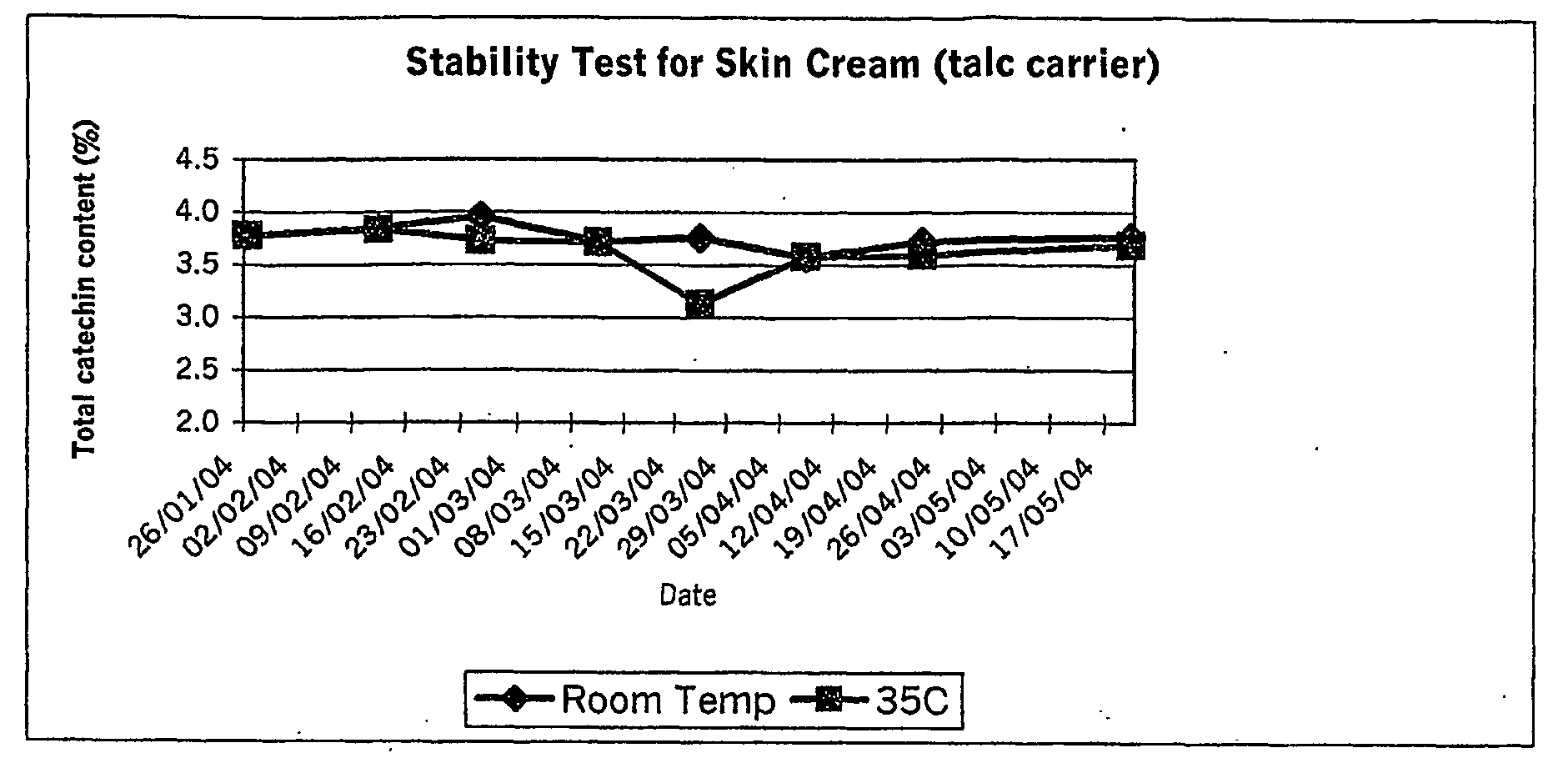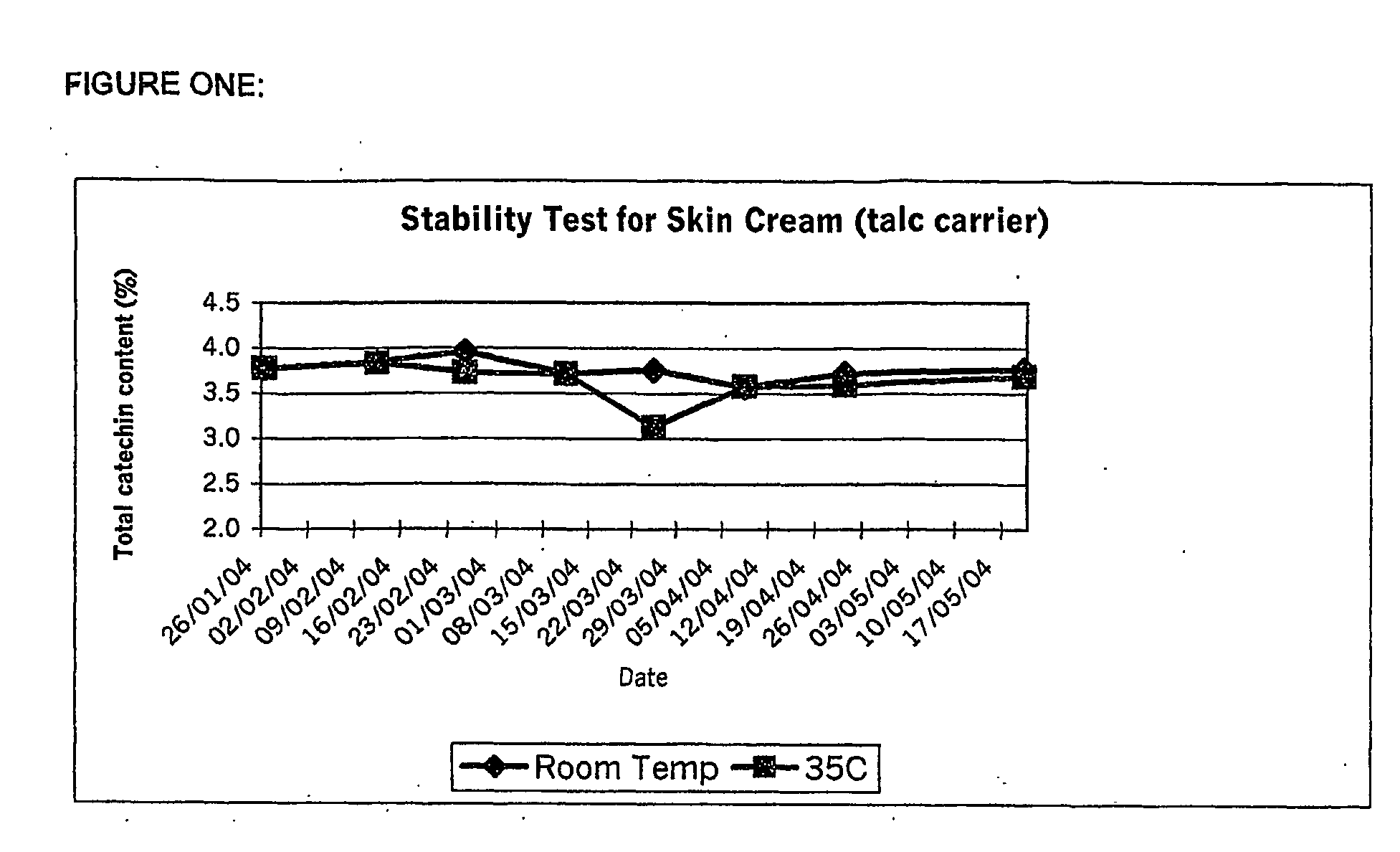Anhydrous topical formulation for polyphenols
a technology of anhydrous topical formulation and polyphenol, which is applied in the direction of biocide, drug composition, aerosol delivery, etc., can solve the problems of poor soluble polyphenols in these oils, high cost, and high cost, and achieve the effect of not inhibiting the ability of polyphenols
- Summary
- Abstract
- Description
- Claims
- Application Information
AI Technical Summary
Benefits of technology
Problems solved by technology
Method used
Image
Examples
example one
Acne Cream
Using Salicylic Acid
[0014]An anhydrous preparation for the treatment of acne consisting of 3% w / w purified green tea extract (comprising at least 70% polyphenols) has been devised which utilizes 0.5% w / w salicylic acid as a suitable binding carrier as follows:[0015]77.1% jojoba oil[0016]15.0% bees wax[0017]2.0% lecithin[0018]2.0% ascorbyl palmitate (vitamin C)[0019]0.2% sorbic acid[0020]3.0% green tea polyphenol extract (70% polyphenols)[0021]0.5% salicylic acid[0022]0.2% tea tree oil
[0023]It is necessary during the formulation process to first triturate the polyphenol and binding carrier until uniform using gentle heat and milling. This polyphenol / carrier can then be added to the balance of the anhydrous mixture to achieve a uniformly disbursed topical mixture upon further mixing and / or milling.
example two
Skin Cream
Using Silica Gel
[0024]A preparation for the treatment of damaged skin consisting of 5% w / w purified green tea extract (comprising at least 70% polyphenols) has been devised which utilizes 6% w / w micronized silica gel as a suitable binding carrier as follows:[0025]67.5% jojoba oil[0026]5.0% dimethyl sulfone[0027]12.0% beeswax[0028]2.0% lecithin[0029]6.0% silica gel (micronized)[0030]5.0% green tea polyphenol extract (70% polyphenols)[0031]0.2% sorbic acid[0032]2.0% ascorbyl palmitate (vitamin C)[0033]0.2% Lavender oil[0034]0.1% Tea tree oil
[0035]It is necessary during the formulation process to first triturate the polyphenol and binding carrier until uniform. This polyphenol / carrier can then be added to the balance of the anhydrous mixture to achieve a uniformly disbursed topical mixture upon further mixing and / or milling.
example three
Skin Cream
Using Talc
[0036]A preparation for the treatment of damaged skin consisting of 5% w / w purified green tea extract (comprising at least 70% polyphenols) has been devised which utilizes 20% w / w talc as a suitable binding carrier as follows:[0037]58.5% jojoba oil[0038]12.0% beeswax[0039]2.0% lecithin[0040]20.0% talc[0041]5.0% green tea polyphenol extract (70% polyphenols)[0042]0.2% sorbic acid[0043]2.0% ascorbyl palmitate (vitamin C)[0044]0.2% Lavender oil[0045]0.1% Tea tree oil
[0046]It is necessary during the formulation process to first triturate the polyphenol and binding carrier until uniform. This polyphenol / carrier can then be added to the balance of the anhydrous mixture to achieve a uniformly disbursed topical mixture upon further mixing and / or milling.
PUM
 Login to View More
Login to View More Abstract
Description
Claims
Application Information
 Login to View More
Login to View More - R&D
- Intellectual Property
- Life Sciences
- Materials
- Tech Scout
- Unparalleled Data Quality
- Higher Quality Content
- 60% Fewer Hallucinations
Browse by: Latest US Patents, China's latest patents, Technical Efficacy Thesaurus, Application Domain, Technology Topic, Popular Technical Reports.
© 2025 PatSnap. All rights reserved.Legal|Privacy policy|Modern Slavery Act Transparency Statement|Sitemap|About US| Contact US: help@patsnap.com


